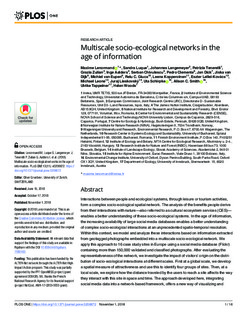Multiscale socio-ecological networks in the age of information
Lenormand, Maxime; Luque, Sandra; Langemeyer, Johannes; Tenerelli, Patrizia; Zulian, Grazia; Aalders, Inge; Chivulescu, Serban; Clemente, Pedro; Dick, Jan; van Dijk, Jiska; van Eupen, Michiel; Giuca, Relu C.; Kopperoinen, Leena; Lellei-Kovacs, Eszter; Leone, Michael; Lieskovsky, Juraj; Schirpke, Uta; Smith, Alison C.; Tappeiner, Ulrike; Woods, Helen
Peer reviewed, Journal article
Published version

Åpne
Permanent lenke
http://hdl.handle.net/11250/2582895Utgivelsesdato
2018Metadata
Vis full innførselSamlinger
- Scientific publications [1392]
Originalversjon
10.1371/journal.pone.0206672Sammendrag
Interactions between people and ecological systems, through leisure or tourism activities, form a complex socio-ecological spatial network. The analysis of the benefits people derive from their interactions with nature—also referred to as cultural ecosystem services (CES)— enables a better understanding of these socio-ecological systems. In the age of information, the increasing availability of large social media databases enables a better understanding of complex socio-ecological interactions at an unprecedented spatio-temporal resolution. Within this context, we model and analyze these interactions based on information extracted from geotagged photographs embedded into a multiscale socio-ecological network. We apply this approach to 16 case study sites in Europe using a social media database (Flickr) containing more than 150,000 validated and classified photographs. After evaluating the representativeness of the network, we investigate the impact of visitors’ origin on the distribution of socio-ecological interactions at different scales. First at a global scale, we develop a spatial measure of attractiveness and use this to identify four groups of sites. Then, at a local scale, we explore how the distance traveled by the users to reach a site affects the way they interact with this site in space and time. The approach developed here, integrating social media data into a network-based framework, offers a new way of visualizing andmodeling interactions between humans and landscapes. Results provide valuable insights for understanding relationships between social demands for CES and the places of their realization, thus allowing for the development of more efficient conservation and planning strategies.
Beskrivelse
Artikkel
